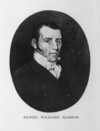DAZEMARD (Dassemat, Dazmard, Dazmat) DE LUSIGNAN, PAUL-LOUIS, captain in the colonial regular troops, commandant; b. at Champlain (Que.) 19 Nov. 1691, only child of Paul-Louis Dazemard de Lusignan and Jeanne Babie; d. 2 Sept. 1764 at Quebec.
Paul-Louis Dazemard de Lusignan’s career followed a familiar pattern: cadet in 1705; ensign, 1712; second lieutenant, 1721; lieutenant, 1734; captain, 1744. In 1734 Lusignan was assistant adjutant at Fort Niagara (near Youngstown, N.Y.). The following year he was appointed commandant of Fort Saint-Joseph (probably Niles, Mich.), a post he held until 1743. According to his service record, compiled in 1766 at the request of his widow who was seeking a pension, he may have been instrumental in 1736 in negotiating and securing a definitive peace with the Sauks and Foxes, thereby ending an expensive war. From 1743 to 1747, Lusignan was commandant at Baie-des-Puants (Green Bay, Wis.). His most important command was Fort Saint-Frédéric (Crown Point, N.Y), which he held from 1749 (officially from 1751) until 1758. During the war years 1755–60 Lusignan served variously at Saint-Frédéric, Carillon (Ticonderoga, N. Y.), Île aux Noix, Saint-Jean, and finally Chambly in 1760, but he apparently did not take part in any major engagements, rather acting as a garrison commander who sent supplies and reinforcements to the fighting troops.
His career of 53 years as an officer was long, but others matched it. Lusignan was, however, more than normally competent, judging by the comments of the authorities. In 1732 Intendant Hocquart* spoke well of him: a “prudent man, who likes his duty and who is able to bring honour to the service.” The following year Hocquart defended him against a charge of private trading, pointing out that it was permissible “for gentlemen in this country” according to the edict of 1685. It is probable, then, that Lusignan, like other post commandants, eked out his meagre pay as a private trader with the Indians, while keeping a watchful eye on the activities of other traders, legal and illegal, passing by his post. In 1744, for example, he was commended by Governor Charles de Beauharnois for dealing with “disorders” in the trade at the Baie des Puants (Green Bay, Lake Michigan).
In 1749 Lusignan requested appointment as permanent commander at Saint-Frédéric, at that time the most advanced French outpost on Lake Champlain. The appointment was strongly recommended by both Governor La Jonquière [Taffanel] and Intendant François Bigot*, the latter pointing out that Lusignan could form an agricultural community around the post thereby lessening the burden of supplying it. The normal function of Saint-Frédéric, which the French government considered of great importance, was to prevent or at least restrain the illegal passage of goods between New France and Albany. The appointment, then, was one of considerable responsibility and the choice of Lusignan open to at least two interpretations. The most charitable is that Lusignan was an experienced officer of proven probity, given the post as a sinecure in his declining years. The other, borne out by the warmth of Bigot’s recommendation, is that Lusignan may have been an agent of the grande société and connived at smuggling, but this interpretation must remain only a suspicion.
In July 1749 Lusignan welcomed to Fort Saint-Frédéric Pehr Kalm*, a prominent Swedish naturalist, en route to Montreal and Quebec from Albany. Kalm found his host to be a man “about fifty years old, well acquainted with polite literature and [who] had made several journeys into this country, by which he had acquired an exact knowledge of several things relative to it.” Other comments confirm that the eminent savant found the Canadian-born and Canadian-educated officer a person of some refinement.
Lusignan was made a knight of the order of Saint-Louis in 1752 as a reward for long and faithful service. Severe illness apparently prevented his departure for France with the troops in 1760. He convalesced in Canada until 1764 and, when on the point of embarkation, died 2 September of a sudden illness. His widow returned to France. Lusignan had married at Montreal, on 8 Jan. 1722, Madeleine-Marguerite, daughter of François-Marie Bouat*. Ten children were born of the marriage; the eldest, Louis-Antoine*, had a distinguished military career.
AN, Col., D2C, 222/4, f.136; 59, f.21; Marine, C7, 190. Pehr Kalm, The America of 1750; Peter Kalm’s travels in North America: the English version of 1770, ed. A. B. Benson (2v., New York, 1966), II, 4. Fauteux, Les chevaliers de Saint-Louis, 152. Le Jeune, Dictionnaire. Tanguay, Dictionnaire. P.-G. Roy, “La famille Dazemard de Lusignan,” BRH, XXXVII (1931), 579–85; “Les commandants du fort Saint-Frédéric,” BRH, LI (1945), 330.
© 1974–2024 University of Toronto/Université Laval
Cite This Article
J. R. Turnbull, “DAZEMARD DE LUSIGNAN, PAUL-LOUIS,” in Dictionary of Canadian Biography, vol. 3, University of Toronto/Université Laval, 2003–, accessed April 23, 2024, http://www.biographi.ca/en/bio/dazemard_de_lusignan_paul_louis_3E.html.
The citation above shows the format for footnotes and endnotes according to the Chicago manual of style (16th edition). Information to be used in other citation formats:
| Permalink: | http://www.biographi.ca/en/bio/dazemard_de_lusignan_paul_louis_3E.html |
| Author of Article: | J. R. Turnbull |
| Title of Article: | DAZEMARD DE LUSIGNAN, PAUL-LOUIS |
| Publication Name: | Dictionary of Canadian Biography, vol. 3 |
| Publisher: | University of Toronto/Université Laval |
| Year of publication: | 1974 |
| Year of revision: | 1974 |
| Access Date: | April 23, 2024 |











